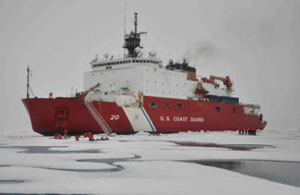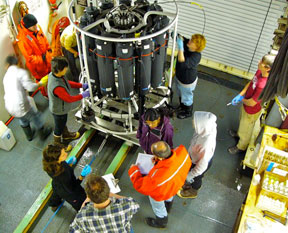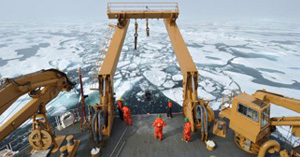New NSF Grant to Scripps and Oregon State Supports Seagoing Research Technicians for Arctic Science
New program bolsters technical expertise on polar icebreaking research vessels
By:
- Mario Aguilera
Published Date
By:
- Mario Aguilera
Share This:
Article Content

Science teams prepared equipment for an "ice station" while the U.S. Coast Guard research icebreaker Healy was stopped in an ice floe during the ICESCAPE II cruise in July 2011.
A new $2.1 million grant from the National Science Foundation (NSF) to Scripps Institution of Oceanography at UC San Diego and Oregon State University (OSU) will allow the most advanced seagoing technical personnel and their expertise to support science in the world’s northernmost seas.
Under the NSF grant, Scripps and OSU will collaborate to create a new program to supply trained technical experts aboard United States Coast Guard (USCG) icebreaking research vessels.
The value of polar research has gained significance in recent years as rising temperatures and melting ice continue to change the environment at the poles, with implications for global climate. Research aboard the USCG ships Healy, Polar Sea, and Polar Star is necessarily broad because so few vessels are able to work in polar waters and serve research projects that span climate change, marine fisheries and ecosystems, marine mammal research, physical oceanography, chemistry, and other areas.
The new grant will fund technicians from Scripps’ Shipboard Technical Support department and OSU’s Marine Technician Group to serve as the research backbone aboard polar research vessels. These groups coordinate the complex scientific operations of dozens of individual research scientists who collaborate aboard the ships during hectic summer field programs and are responsible for the safe and accurate operation of myriad shipboard instruments. Often unheralded, these technical experts are trained to use a broad array of scientific equipment and serve as liaisons between the scientists and the ship’s crew to insure that costly investments in polar research pay off with the largest amount of accurate data possible.

During a recent Arctic mission aboard USCG's Healy, researchers focused on a seawater sampling device.
Research marine technicians oversee operation of various oceanographic instruments and equipment at sea, including conductivity, temperature, and depth (CTD) instruments, which collect samples of sea water at various depths for laboratory analysis; multibeam swath sonar and echosounders for seafloor mapping; and seafloor coring instruments used to analyze long-term changes in the ocean.
For San Diego’s economy, the new award carries $1.37 million over three years to Scripps. In addition to the creation of a new technical manager position, the grant provides fresh support for high-value technical jobs that exist at Scripps, and will result in additional San Diego-area spending with the reorganization of the program's logistical support here from the east coast.
Scripps’ STS group has been involved with Healy even before the vessel was launched in 1999. STS technicians were contracted by USCG to consult on the vessel’s scientific systems during its design and construction and have provided marine research technical support since then.
“This program builds on Scripps’ heritage of exporting technical expertise throughout the U.S. academic research fleet, so that the methods for improving efficiency and accuracy that we develop at Scripps can benefit the broader oceanographic community,” said Bruce Appelgate, associate director for Ship Operations and Marine Technical Support at Scripps. “Now more than ever, global policymakers are looking to scientists for accurate information about our polar environments. By partnering with the outstanding team at Oregon State, we strengthen our ability to insure that scientific observations performed in the Arctic Ocean will be of the highest possible quality.”

A conductivity, temperature and depth (CTD) seawater sampling instrument is deployed off Healy in July 2011.
The grant also represents a model for improving the quality of scientific support within current federal science budgets, which have tightened in recent years. Marine technicians have typically worked aboard their own institutional research vessels. The new program combines the existing strengths of two leading oceanographic institutions to support polar research aboard USCG vessels as well, enabling instant, cost-effective access to experienced technicians.
“By working early on and directly with the scientists who will sail on the U.S. Coast Guard icebreakers, marine research technicians’ cruise support can be focused closely on the science goals of the expedition,” said Jim Swift, a research oceanographer at Scripps. “This will provide strong science support services on the icebreakers while being efficient and cost effective. Scripps also has a long history of working with the Arctic Icebreaker Coordinating Committee—the scientific oversight body for science on U.S. Arctic icebreakers—and this has provided insight on fruitful approaches we can take regarding at-sea science support.”
Beyond science support, students participate on many Arctic research cruises and marine technicians often demonstrate, educate, and train students in the use of technology at sea.
“Most of our technicians have worked off Alaska, in the Bering Sea, and other extreme environments,” said Daryl Swensen, superintendent of OSU’s Marine Technician Group, “so it should be familiar in many ways. But it will be exciting to be a part of this polar research program.”

An NSF grant will create a new program to train science support technicians aboard U.S. Coast Guard icebreaking research vessels such as Healy, depicted here in the Arctic Ocean north of the Chukchi Sea and Alaska in July 2011. (Optics-package)
Scripps and OSU are each strongly committed to improving the scientific capabilities of all the vessels in the U.S. academic research fleet. Both groups work closely with partners within the University-National Oceanographic Laboratory System (UNOLS), an organization of 61 U.S. academic institutions and national laboratories that collaborate on resources that support oceanographic research. There are currently 21 ships in the U.S. research fleet operated by institutions around the country. Oregon State operates R/V Wecoma, while Scripps operates R/Vs Roger Revelle, Melville, New Horizon, and Robert Gordon Sproul. Scripps also operates the research platform FLIP.
Last year, the U.S. Office of Naval Research selected Scripps as the operator of a new Ocean Class scientific research vessel, which is currently being designed with input from Scripps oceanographers. The U.S. Navy is providing more than $88 million to construct the vessel, which is anticipated to be ready for Scripps to operate by 2015.
Share This:
You May Also Like
Stay in the Know
Keep up with all the latest from UC San Diego. Subscribe to the newsletter today.



